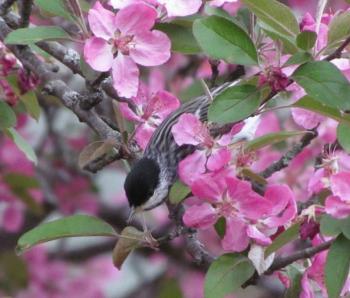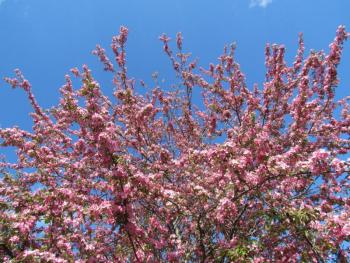An Accomplished Catbird and a Tree of Bursting Pink
Two themes have dominated our backyard natural history observations this week. One of them is specific not only to one particular bird species but to a particular individual bird. We have always had one or two pairs of gray catbirds that have territories in and around our yard. Some years we know that a pair has nested right on our property. One year a pair nested in the center of a tangled forsythia bush out back. It’s been some weeks since we spotted the first gray catbird here, and it wasn’t until a number of weeks later that one began singing regularly. Over the last 10 days the singing has become louder and more persistent. We’ve even discovered, through the use of our automated recording device that monitors the calls of night-migrating birds, that one of the catbirds begins singing each morning between 3:15 and 3:30 AM! The songs are picked up by the microphone and sometimes obscure the calls of the last of the night’s migrating birds passing by.
Gray catbirds are in the same family—Mimidae, the Mimics—as northern mockingbirds and brown thrashers. Though they are closely related to these two famously accomplished song mimics, many individual catbirds don’t seem to display very extensive repertoires of song and call imitations, and instead their songs consist primarily of lots of squeaky phrases. Unlike northern mockingbirds that repeat phrases and imitations many times in succession, and brown thrashers that repeat each phrase twice, gray catbirds usually don’t repeat phrases at all.
All of this makes the individual catbird in our yard rather special. He showcases both talents: He is an accomplished mimic, and he often repeats the imitations more than twice in succession.
We have heard him do excellent imitations of the teetering alarm calls of the bald eagle, the liquid chatter of tree swallows, the “fwee-bwee” song of the eastern phoebe, the harsh rattle of the Baltimore oriole, calls of Eastern kingbird, American robin, blue jay, northern cardinal, American goldfinch, black-capped chickadee, and others.
This afternoon we even heard him do a long, repeated series of osprey calls that sounded exactly like the ospreys that nest down by the stream below the house.
The second major nature observation theme for us this week involves one of the favorite places from where this talented catbird likes to sing: the flowering crabapple tree beside the driveway. Many birds use this tree as a song perch including our resident song sparrow, one or more of the local northern cardinals, black-capped chickadees, American goldfinches, and tufted titmice. But this past week, the tree became popular for another reason: Its thousands of flower buds began bursting open, turning into a pink paradise from which billows a cloud of sweet scent.
Every May when this happens, birds seem to flood into it, virtually disappearing among the sea of petals. It may not be surprising to hear that the catbirds enjoy poking into these flowers as they are famously great lovers of orange halves and grape jelly when provided to them at the backyard feeder. The same is true of migrant Baltimore orioles. Late-arriving warblers, just up from South and Central America, have also been spotted in this tree over many a late-May morning.
One of the species that we find the most curious frequenter of this flowering crabapple are the house sparrows. We don’t know if this is common to house sparrows everywhere, but our local flock just seems to go nuts when this tree’s blossoms hit their peak. They flit through the tree, probing into the flowers one after the other. Some of the other birds in the tree, the chickadees and warblers, for example, can be seen peering into flowers and among leaves to snap up any tiny insects may also be attracted to the new blossoms. But the house sparrows show no sign of doing anything but poking directly into the flowers. We don’t know if it is nectar, pollen, petals, insects, or all of the above that the house sparrows are so drawn to.
It’s mesmerizing to sit and watch the various birds in that beautiful sea of pink. We expect to be enjoying it immensely over the next week or so of blooming, as it hosts the final wave of spring migrant birds on their way north.
Jeffrey V. Wells, Ph.D., is a Fellow of the Cornell Lab of Ornithology and Vice President of Boreal Conservation for National Audubon. Dr. Wells is one of the nation's leading bird experts and conservation biologists and author of the “Birder’s Conservation Handbook.” His grandfather, the late John Chase, was a columnist for the Boothbay Register for many years. Allison Childs Wells, formerly of the Cornell Lab of Ornithology, is a senior director at the Natural Resources Council of Maine, a nonprofit membership organization working statewide to protect the nature of Maine. Both are widely published natural history writers and are the authors of the popular book, “Maine’s Favorite Birds” (Tilbury House) and “Birds of Aruba, Bonaire, and Curaçao: A Site and Field Guide,” (Cornell University Press).


























